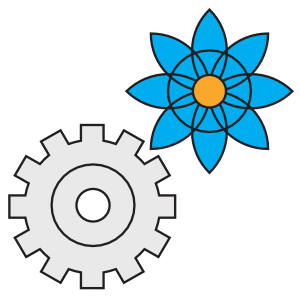Baukasten:100 Points Factors of Technology Design - digital
100 Points – Demands on Technology Design - Digital
The design of technology and the resulting technological development often just seems to happen. We sometimes forget that technology design is determined by individuals making certain decisions on a basis of well-defined criteria. This building block invites participants to reflect upon criteria they find important when designing technology. They compare their demands and the currently most dominant criteria for technology design. This leads to the following question: Who can actually participate in the design process and how can we find compromises when demands conflict?
There are numerous and frequently conflicting demands on technology which are rarely pointed out clearly. As they are determined by habit, tradition and cultural customs the design process of technology is confusing and hard to understand. Often it is not even possible to tell who is promoting which demands for technological devices, processes and systems.
Participants come up with a set of values for technology design. Then they weigh them by distributing 100 points among their values. In this way, implicit demands are revealed. The participants become aware of their personal prioritisation regarding criteria for technology design and the conflicts that may arise between their personal demands and those of others.
Preparation and Follow-Up
Facilitators’ Preparation
The facilitators provide the participants with an online questionnaire as preparation. It includes the following questions:
- Question 1: What technological device/process are you analysing?
- Question 2: Which demands is this device/process supposed to meet?
- Question 3: Who or which group promotes these demands?
- More details can be found in the Materials
The facilitators assess the participants' preparation and create a visual summary (e.g. word-cloud). It should be clearly visible which answers occur more frequently than others. They pay attention to the following aspects:
- Question 1 - Which products/processes have been chosen frequently and why? Which products/processes were mentioned less or not at all and why? What needs are being met? What do the chosen products/processes say about the participants/group?
- Question 2 - The facilitators pay attention to the following questions: Which demands have been identified? Which ones were not or rarely mentioned? Where are the blind spots of the participants and why do they exist?
- Question 3 - Which persons/groups are named? Which ones are not or rarely mentioned? Where are the blind spots of the participants and why do they exist? How dominant are these persons/groups in the design process of technology?
The facilitators reflect upon their own values/demands in relation to the design of technology. They research some case studies that highlight the fact that "weight" is given differently to different demands on technology design.
The facilitators set up forum posts with the tasks for the session itself and the follow-up.
Participants’ Preparation
The participants select three concrete technological devices or processes. They analyse which demands have been taken into account in their design and which individuals or groups have promoted these demands. This is done with an online questionnaire.
Participants’ Follow-Up
The participants choose a technological device, process or system. They evaluate it using the values gathered in their group during the session. They point out the individuals, groups and structures that significantly determine the design and suggest how individuals or groups can make sure that presently neglected demands are taken into account more frequently.
The participants post their follow-up as a replay to the follow-up task in the forum. Instead of in a forum the follow-up can also be done in the participants’ learning journal.
Schedule
Minute 00 - Introduction und Personal Demands
Notes
The participants write down demands/values for technology design. In a second step they score them. The facilitators assign these two tasks separately to make sure the participants do not think about prioritisation when choosing their values.
The facilitators point out that this task is all about the participants’ personal attitude: Which demands do YOU as a person want to be considered when technology is designed? How would YOU as a person like them to be ranked?
Slides
Task 1: Your Demands on Technology Design – Individual Work - 3 min
- List all important values/demands YOU want to be considered when technology is designed.
- e.g. profitability
Task 2: Rank your demands – Individual Work - 2 min
- Score the values/demands you have just noted down by distributing 100 points in total amongst them.
- e.g. profitability (20 points) - value 2 (30 points) - value 3 (50 points)
Minute 05 – Evaluation of Participants‘ Preparation and Weight of Demands
Notes
The facilitators present the short evaluation and visual summary of the participants’ preparation they have set up.
The facilitators shortly introduce the tool “Weight of Demands”.
Slides
Evaluation of technological Devices/Processes
- insert visual summary of question 1 here -
Evaluation of Demands
- - insert visual summary of question 2 here -
Evaluation of Influential Persons/Groups
- - insert visual summary of question 3 here -
Tool - Weight of requirements
All humans are seen as equal before the law, but their respective needs and requirements carry varying weights in terms of shaping technology and society.
Generally, only a few requirements are explicitly considered when developing a product, and these usually originate from people who use, engineer, or profit from the resulting product. However, it is important when designing any technology to consider all people who may be affected by its use, production, etc., regardless of whether they have different or conflicting requirements, such as the conservation of nature or humane working conditions.
Minute 10 – Demands on Technology Design - Group Work
Notes
The facilitators explain the tasks and create breakout sessions with 3 to 5 participants per group.
The groups work on their tasks and post their results in the forum as a reply to the post including the tasks.
Slides
Overview of Tasks - Small Group Work - 15 min
- Task 1: Present your personal demands and rankings to each other
- Task 2: Agree on one set of demands as a group and score it
- Task 3: Analyze your group’s choice and ranking
- Task 4: Post your results in the forum
Task 1 - Present your personal demands and rankings - 5 min
- Briefly present your values and your ranking to each other
- Pay attention to similarities/differences when the others speak
- Refer to the others when you speak
Task 2 - Agree on one set of demands as a group and score it - 5 min
- Agree on values as a group and distribute 100 points among them
Task 3 - Analyze your group’s choice and ranking - 5 min
- Analyse your group work together by concentrating on some of the following aspects:
- Reflect your work process
- Which one of you was involved in the process and how?
- Who had the biggest influence on the result and why?
- How did you make your decisions?
- Weight of Demands
- Are all people equally taken into consideration?
- How much does your social background determine your demands/ranking? (young, studying, basic needs are satisfied...)
- Transfer
- Where are your blind spots?
- What is the relationship between the people who are involved in the construction, production, use or disposal of technology? How is the relationship between decision-makers, users and those affected?
Task 4 - Post your results in the forum
- Choose one person per group to post your demands/ranking in this forum
- - Insert link to forum here –
- - if chat is used instead of forum: value A (50) - value B (30) - value C (20) -
Minute 25 - Evaluation and Follow-Up
Notes
The breakout sessions end. One or two groups present their demands/ranking/analysis to the others. The forum/chat serves as a visual support.
The facilitators select a few aspects of the session and steer the final discussion towards these main questions:
- Who has currently the biggest influence on the design of technology?
- How can all affected parties be involved?
The facilitators close the discussion referring to the tool “Weight of Demands” and present the follow-up.
Slides
Follow-Up: Case Study
- Chooses a historical, contemporary or personal technological device, process or system
- Evaluates it with the values/ranking from your group work
- Analyse who could push forward his/her demands and who could not
- Describe how individuals and groups can make sure that certain demands on technology design are taken into account more frequently
Notes and Remarks
Authors’ Note
Building Block can be used very flexibly in terms of time and working methods. The building block is, as a shortened version, part of the first session in the seminar at TU Berlin (without participants' preparation). VDI 3780 - technology assessment can be used as an extension of the block or as an inspiration for the learning journal Dealing with conflicting goals and the role of the participants in these conflicts can extend the block
Further Notes
Still to come.
References
- VDI 3780 – Technology Assessment - Guidelines published by the Association of German Engineers (VDI)
Materials
Participants’ Preparation
Notes
The facilitators set up a forum post with the following tasks. The participants work on the tasks and post them as a reply to the post.
Slides
Demands and Stakeholders concerning Technology Design
- Please choose three specific technological devices/processes and briefly answer the following questions in a reply to this post.
- First Device/Process
- What technological device/process are you analysing? - insert text-box here -
- Which demands is this device/process supposed to meet? - insert text-box here -
- Who or which group promotes these demands? - insert text-box here -
- Second Device/Process
- What technological device/process are you analysing? - insert text-box here -
- Which demands is this device/process supposed to meet? - insert text-box here -
- Who or which group promotes these demands? - insert text-box here -
- Third Device/Process
- What technological device/process are you analysing? - insert text-box here -
- Which demands is this device/process supposed to meet? - insert text-box here -
- Who or which group promotes these demands? - insert text-box here -
Participants’ Follow-Up
Notes
The facilitators set up a forum post with the following tasks. The participants work on the tasks and post them as a reply to the post.
Follow-Up Task: Case study
Please Choose one historical, contemporary or personal technological device, process or system. Post your Ideas on the following questions as a brief reply to this post and comment on each other's ideas.
- How do you evaluate your case with the values/ranking from your group work?
- Who could push forward his/her demands in your case and who could not?
- How can individuals/groups make sure that certain demands on the technology design of your case are taken into account more frequently?

